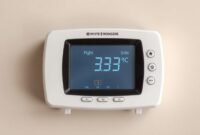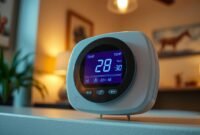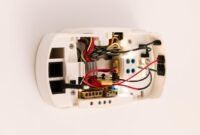Are you worried about the blinking snowflake icon on your White Rodgers thermostat? You’re not alone. This small symbol can cause a lot of stress for homeowners. They worry if their cooling system is working right.
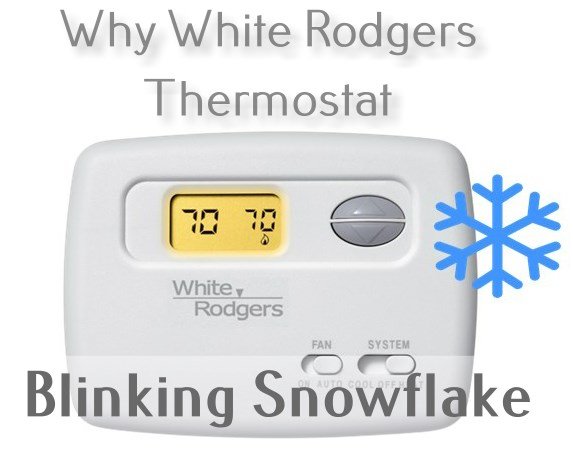
The meaning of the snowflake icon isn’t always clear. It can make you feel like your HVAC is playing tricks on you. But, before you call an expensive technician, let’s explore what this icon really means.
Understanding the Snowflake Icon on Your Thermostat Display
Thermostat error symbols can be confusing. The white Rodgers snowflake icon is key in controlling your home’s temperature. Let’s explore what these symbols mean in your thermostat guide.
Read also: Troubleshooting of Atwood 6-gallon Water Heaters Common Issues
Basic Functions of Thermostat Icons
Thermostat icons do more than look good. They tell you about your cooling system’s status. The snowflake icon shows if your system is cooling or not.
- Steady snowflake: Cooling mode is active but not running
- Blinking snowflake: Active cooling cycle or system delay
- No snowflake: Heating mode or system is off
What Different Icon States Mean
Knowing thermostat error symbols helps you spot HVAC problems fast.
| Icon State | Meaning | Recommended Action |
|---|---|---|
| Steady Snowflake | Cooling mode ready | No action needed |
| Blinking Snowflake | Cooling cycle in progress | Monitor system performance |
| Rapidly Blinking Snowflake | Potential system error | Check system settings |
Normal vs Abnormal Blinking Patterns
Not all blinking is a problem. A slow blink means everything’s working fine. But rapid blinking could mean it’s time for a check-up.
- Normal blink: Consistent, slow rhythm
- Abnormal blink: Rapid, irregular pattern
- Potential issues: Compressor protection, sensor problems
Learning about these patterns makes you more confident in controlling your home’s temperature.
Common Causes of White Rodgers Thermostat Blinking Snowflake
Seeing a blinking snowflake on your White Rodgers thermostat can mean a few things. It might signal a cooling system delay or other issues. Several factors could cause this, from simple maintenance to complex system problems.
Here are some common white rodgers issues that might show a blinking snowflake:
- Improper initial installation
- Dirty or clogged air filters
- Low or worn-out batteries
- Potential system communication glitches
Now, let’s look at what might be causing your thermostat’s blinking snowflake:
| Cause | Potential Solution |
|---|---|
| Bad Installation | Check wire connections and internal switch settings |
| Dirty Air Filters | Clean or replace filters every 2-3 weeks |
| Battery Issues | Replace batteries immediately |
| System Glitches | Perform a factory reset |
I suggest you start by checking the easy stuff first. Look at the batteries and air filters. If that doesn’t work, you might have a bigger problem. In that case, it’s time to call a pro.
Protection Mode and Cooling System Delay Explained
When your White Rodgers thermostat shows a blinking snowflake icon, it means something important. It’s a sign that your cooling system is being protected. This delay is key to keeping your air conditioning safe from harm.
Compressor protection is not just a feature; it’s a vital defense for your HVAC system. The delay helps stop your air conditioning from working too hard. This could damage your system.
Why Delay Mode Activates
The cooling delay kicks in for a few reasons:
- After recent power cuts
- After big changes in cooling settings
- When there are electrical issues
Duration of Protection Cycles
The protection cycle usually lasts about 3-5 minutes. This short time lets your system adjust and avoid damage. It helps your equipment last longer.
Benefits of Compressor Protection
Knowing about protection mode has many benefits:
- It stops early wear on compressor parts
- It cuts down on unexpected breakdowns
- It keeps energy use at its best
- It saves on repair costs
If delays keep happening, it might mean there’s a bigger issue. You should get a pro to check it out.
Thermostat Settings That Trigger the Blinking Icon
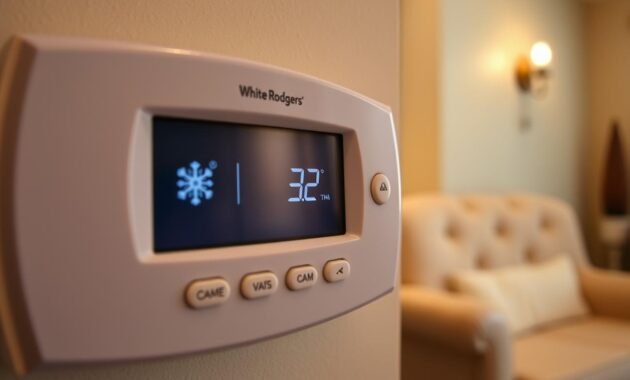
Working with a White Rodgers thermostat, some settings can make the blinking snowflake icon appear. Knowing these settings helps find cooling system problems fast.
The blinking snowflake shows when the thermostat changes settings or goes into protection mode. Here are the main thermostat settings that might cause this:
- Cooling setpoint adjustments
- Switching between heating and cooling modes
- Activating programmed cooling schedules
- Changing fan operation settings
Details in the thermostat settings affect the snowflake icon’s behavior. The ELEC/GAS switch controls the circulator fan’s operation in different modes. Also, the O/B terminal switch affects the changeover relay in heating and cooling cycles.
If you see the blinking snowflake often, check your White Rodgers thermostat settings. Some settings might turn on protection mode, stopping your cooling system.
Looking at your thermostat settings can often solve the blinking problem. Pay attention to:
- Current temperature differential
- Programmed schedules
- Mode selections
- Fan configuration
Most blinking issues are due to protection mechanisms to avoid damage to your cooling equipment. Knowing these settings helps manage your White Rodgers thermostat better.
How Temperature Differential Affects Snowflake Blinking
Learning about temperature thresholds and cooling cycles can improve your White Rodgers thermostat’s performance. The difference in temperature is key to keeping your home comfortable and saving energy.
Understanding Temperature Control Mechanics
Working with HVAC systems shows that temperature thresholds are vital for home comfort. The cooling system starts when the temperature hits certain levels. This leads to different cooling cycles that affect how well the system works.
Impact on Cooling System Performance
- Smaller temperature differentials trigger more frequent cooling cycles
- Larger differentials result in longer, less frequent cooling periods
- Optimal thermostat settings balance comfort and energy consumption
Optimal Setting Ranges
Choosing the right temperature thresholds can greatly improve your system’s efficiency. Experts suggest these optimal setting ranges:
| Differential Range | Cycle Characteristics | Energy Efficiency |
|---|---|---|
| 0.5°F – 1°F | Short, Frequent Cycles | Moderate |
| 1°F – 2°F | Balanced Cooling | High |
| 2°F – 3°F | Long, Infrequent Cycles | Maximum |
By adjusting your thermostat’s temperature thresholds, you can find the perfect balance between comfort and saving energy.
Troubleshooting White Rodgers Thermostat System Communications
Dealing with thermostat system communications can be tough. My hvac troubleshooting guide will help you fix White Rodgers thermostat connection issues fast and well.
When you’re troubleshooting, check a few key things:
- Make sure all wire connections are tight and secure
- Check the voltage (it should be 24 VAC)
- Confirm the C (common) wire is connected right
- Validate the O/B terminal switch setup
White Rodgers troubleshooting often means looking at where signals might break down. Loose connections can stop signals between your thermostat and HVAC system.
| Communication Issue | Potential Cause | Recommended Action |
|---|---|---|
| No Display Response | Loose Wire Connection | Inspect and Reconnect Terminals |
| Intermittent Signals | Incorrect Voltage | Measure and Stabilize Voltage |
| System Not Responding | Misconfigured Terminal Switch | Adjust O/B Terminal Settings |
If you see error codes or strange icon behavior, it’s time to check your user manual. Each White Rodgers thermostat has its own way to troubleshoot.
When to Reset Your White Rodgers Thermostat
Knowing when and how to reset your White Rodgers thermostat can save you time and prevent frustrating technical issues. A reset thermostat guide is key when you face problems like unresponsive controls or unusual display behavior.
Understanding the right white rodgers reset technique is important. It keeps your home comfortable and ensures your thermostat works well. Before you start, think about these scenarios:
- Incorrect temperature readings
- Unresponsive control buttons
- Continuous blinking icons
- System communication errors
Step-by-Step Reset Process
Here’s a simple reset method for most White Rodgers thermostats:
- Remove the thermostat from its wall plate
- Remove batteries (if applicable)
- Wait 30 seconds to fully discharge the system
- Reinsert batteries or reattach the thermostat
Post-Reset Configuration
After resetting, you’ll need to set up your thermostat again. This includes:
- Resetting date and time
- Reprogramming temperature schedules
- Verifying system mode settings
Pro tip: Always check your specific model’s user manual for exact reset steps. Different White Rodgers models might have slight differences in the reset process.
| Reset Action | Recommended Frequency |
|---|---|
| Standard Reset | Every 6-12 months |
| Battery Replacement | Annually |
| Professional Inspection | Every 2 years |
If you’re not sure about resetting or have ongoing issues, it’s wise to call a professional HVAC technician.
Read also: Hot Water Heater Settings Top and Bottom on Electric Units
Maintenance Tips to Prevent Cooling System Issues

To keep your HVAC system working well, you need to take care of it regularly. I’ll show you how to avoid cooling problems and keep your system running efficiently.
Regular maintenance is key to making your cooling system last longer. Here are important steps to keep your HVAC system in great shape:
- Change air filters every 1-3 months to maintain optimal airflow
- Clean indoor vents and outdoor unit regularly
- Check thermostat battery levels annually
- Schedule professional HVAC inspections once a year
Your thermostat is important for avoiding cooling system issues. Keep it away from sunlight, drafts, and extreme temperatures. These can harm its performance.
| Maintenance Task | Frequency | Purpose |
|---|---|---|
| Air Filter Replacement | Every 1-3 months | Ensure optimal airflow and system efficiency |
| Thermostat Battery Check | Annually | Prevent programming and communication issues |
| Professional HVAC Inspection | Once per year | Comprehensive system health assessment |
By following these hvac maintenance tips, you’ll reduce the chance of sudden breakdowns. This will help keep your cooling system running smoothly. Remember, taking small steps now can save you a lot of money later.
When to Contact HVAC Professional
Knowing when to get hvac professional help can save you money and prevent damage. Some issues might seem small, but others need expert care.
I suggest calling an HVAC professional in these situations:
- Persistent system short-cycling
- Unusual mechanical noises
- Inconsistent temperature readings
- Frequent error codes
- Suspected electrical problems
Thermostat repair is not always a job for DIY. Professional technicians can find complex issues you might miss. They use special tools to find problems that aren’t obvious.
When a technician checks your system, they will:
- Do a full system check
- Look at electrical connections
- Check refrigerant levels
- Test how well the system works
- Tell you exactly what repairs or replacements you need
Getting professional cooling system service can stop big problems, make your HVAC last longer, and save energy. Don’t wait for a small issue to turn into a big, expensive problem.
Conclusion
Understanding your White Rodgers thermostat doesn’t have to be hard. Knowing about the blinking snowflake icon and how to troubleshoot can keep your home comfy and save energy. Studies show smart thermostats can cut energy bills by up to 23% with the right care.
Good thermostat care is more than fixing problems. It’s about being ahead of your home’s climate needs. You now know how to manage your cooling system better. Smart thermostats, like the Sensi Touch, make it easier to control your home’s temperature.
While you can solve many issues on your own, some need a pro. If problems keep coming back, call an HVAC expert. Your comfort and system’s life depend on quick, correct fixes. Stay alert and informed to keep your cooling system in top shape all season.
Your White Rodgers thermostat guide has prepared you to face cooling system problems head-on. Stay ahead, stay cozy!
